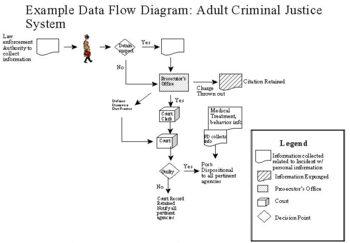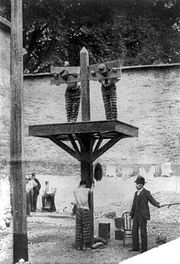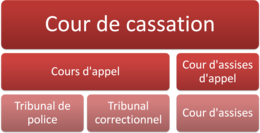The insanity defense, also known as the mental disorder defense, is an affirmative defense by excuse in a criminal case, arguing that the defendant is not responsible for their actions due to a psychiatric disease at the time of the criminal act. This is contrasted with an excuse of provocation, in which the defendant is responsible, but the responsibility is lessened due to a temporary mental state. It is also contrasted with the justification of self defense or with the mitigation of imperfect self-defense. The insanity defense is also contrasted with a finding that a defendant cannot stand trial in a criminal case because a mental disease prevents them from effectively assisting counsel, from a civil finding in trusts and estates where a will is nullified because it was made when a mental disorder prevented a testator from recognizing the natural objects of their bounty, and from involuntary civil commitment to a mental institution, when anyone is found to be gravely disabled or to be a danger to themself or to others.

In criminal justice, particularly in North America, correction, corrections, and correctional, are umbrella terms describing a variety of functions typically carried out by government agencies, and involving the punishment, treatment, and supervision of persons who have been convicted of crimes. These functions commonly include imprisonment, parole, and probation. A typical correctional institution is a prison. A correctional system, also known as a penal system, thus refers to a network of agencies that administer a jurisdiction's prisons, and community-based programs like parole, and probation boards. This system is part of the larger criminal justice system, which additionally includes police, prosecution and courts. Jurisdictions throughout Canada and the US have ministries or departments, respectively, of corrections, correctional services, or similarly-named agencies.
The following outline is provided as an overview of and topical guide to criminal justice:

Penology is a subfield of criminology that deals with the philosophy and practice of various societies in their attempts to repress criminal activities, and satisfy public opinion via an appropriate treatment regime for persons convicted of criminal offences.
Probation in criminal law is a period of supervision over an offender, ordered by the court often in lieu of incarceration.
Articles related to criminology and law enforcement.

A probation or parole officer is an official appointed or sworn to investigate, report on, and supervise the conduct of convicted offenders on probation or those released from incarceration to community supervision such as parole. Most probation and parole officers are employed by the government of the jurisdiction in which they operate, although some are employed by private companies that provide contracted services to the government.
Throughout the history of criminal justice, evolving forms of punishment, added rights for offenders and victims, and policing reforms have reflected changing customs, political ideals, and economic conditions.

Within the criminal justice system of Japan, there exist three basic features that characterize its operations. First, the institutions—police, government prosecutors' offices, courts, and correctional organs—maintain close and cooperative relations with each other, consulting frequently on how best to accomplish the shared goals of limiting and controlling crime. Second, citizens are encouraged to assist in maintaining public order, and they participate extensively in crime prevention campaigns, apprehension of suspects, and offender rehabilitation programs. Finally, officials who administer criminal justice are allowed considerable discretion in dealing with offenders.

In criminology, the classical school usually refers to the 18th-century work during the Enlightenment by the utilitarian and social-contract philosophers Jeremy Bentham and Cesare Beccaria. Their interests lay in the system of criminal justice and penology and indirectly through the proposition that "man is a calculating animal," in the causes of criminal behavior. The classical school of thought was premised on the idea that people have free will in making decisions, and that punishment can be a deterrent for crime, so long as the punishment is proportional, fits the crime, and is carried out promptly.

The American juvenile justice system is the primary system used to handle minors who are convicted of criminal offenses. The system is composed of a federal and many separate state, territorial, and local jurisdictions, with states and the federal government sharing sovereign police power under the common authority of the United States Constitution. The juvenile justice system intervenes in delinquent behavior through police, court, and correctional involvement, with the goal of rehabilitation. Youth and their guardians can face a variety of consequences including probation, community service, youth court, youth incarceration and alternative schooling. The juvenile justice system, similar to the adult system, operates from a belief that intervening early in delinquent behavior will deter adolescents from engaging in criminal behavior as adults.
A presentence investigation report (PSIR) is a legal document that presents the findings of an investigation into the "legal and social background" of a person convicted of a crime before sentencing to determine if there are extenuating circumstances which should influence the severity or leniency of a criminal sentence. The PSIR is a "critical" document prepared by a probation officer via a system of point allocation, so that it may serve as a charging document and exhibit for proving criminal conduct. The PSIR system is widely implemented today.

Pre-crime is the idea that the occurrence of a crime can be anticipated before it happens. The term was coined by science fiction author Philip K. Dick, and is increasingly used in academic literature to describe and criticise the tendency in criminal justice systems to focus on crimes not yet committed. Precrime intervenes to punish, disrupt, incapacitate or restrict those deemed to embody future crime threats. The term precrime embodies a temporal paradox, suggesting both that a crime has not yet occurred and that it is a foregone conclusion.

The judicial system of Sweden consists of the law of Sweden and a number of government agencies tasked with upholding security and rule of law within the country. The activities of these agencies include police and law enforcement, prosecution, courts, and prisons and other correctional services.

Crime in New Zealand encompasses criminal law, crime statistics, the nature and characteristics of crime, sentencing, punishment, and public perceptions of crime. New Zealand criminal law has its origins in English criminal law, which was codified into statute by the New Zealand parliament in 1893. Although New Zealand remains a common law jurisdiction, all criminal offences and their penalties are codified in New Zealand statutes.

The criminal justice system of the Netherlands is the system of practices and institutions of the Netherlands directed at upholding social control, deterring and mitigating crime, and sanctioning those who violate laws with criminal penalties and rehabilitation efforts. The Netherlands' criminal code is based on the Napoleonic Code, imposed during the time of the French Empire. The Dutch largely kept the Napoleonic Code after their independence, but tempered it with a significantly more rehabilitative penological focus.
In 2008, there were 415,810 crimes reported in the U.S. state of North Carolina, including 605 murders. In 2014, there were 318,464 crimes reported, including 510 murders.
Bail in the United States refers to the practice of releasing suspects from custody before their hearing, on payment of bail, which is money or pledge of property to the court which may be refunded if suspects return to court for their trial. Bail practices in the United States vary from state to state.

Criminal justice reform seeks to address structural issues in criminal justice systems such as racial profiling, police brutality, overcriminalization, mass incarceration, and recidivism. Reforms can take place at any point where the criminal justice system intervenes in citizens’ lives, including lawmaking, policing, sentencing and incarceration. Criminal justice reform can also address the collateral consequences of conviction, including disenfranchisement or lack of access to housing or employment, that may restrict the rights of individuals with criminal records.

French criminal law is "the set of legal rules that govern the State's response to offenses and offenders". It is one of the branches of the juridical system of the French Republic. The field of criminal law is defined as a sector of French law, and is a combination of public and private law, insofar as it punishes private behavior on behalf of society as a whole. Its function is to define, categorize, prevent, and punish criminal offenses committed by a person, whether a natural person or a legal person. In this sense it is of a punitive nature, as opposed to civil law in France, which settles disputes between individuals, or administrative law which deals with issues between individuals and government.














